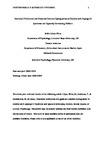Emotional Preferences and Goals and Emotion Dysregulation in Children with Asperger’s Syndrome and Typically Developing Children
| dc.contributor.author | Lopez-Perez, B | |
| dc.contributor.author | Ambrona, T | |
| dc.contributor.author | Gummerum, M | |
| dc.date.accessioned | 2018-01-09T16:30:02Z | |
| dc.date.issued | 2018-09 | |
| dc.identifier.issn | 2044-8260 | |
| dc.identifier.issn | 2044-8260 | |
| dc.identifier.uri | http://hdl.handle.net/10026.1/10521 | |
| dc.description.abstract |
Objectives: Emotion goals lie at the heart of emotion regulation, as people have to first decide what emotions they want to feel before engaging in emotion regulation. Given that children with Asperger’s Syndrome (AS) are characterized by exhibiting difficulties in emotion regulation, studying whether they display similar or different emotion goals compared to typically developing children (TD) may provide insightful information. Methods: Thirty AS and 30 TD children (10-12 years) reported about their general (i.e., how they want to feel in general) and contextualized (i.e., how they want to feel when confronting vs. collaborating with someone) emotion goals, and about their difficulties in emotion regulation through questionnaires. Results: Results showed that both groups did not differ in their general emotional goals and in their contextualized emotion goals for happiness for collaboration and anger for confrontation. AS children only differed from TD children in a higher preference for sadness for collaboration and happiness for confrontation. These emotion goals predicted their difficulties to engage in goal-directed behaviour. Conclusions: The obtained results support the need to further study emotion goals as an aspect of emotion dysregulation, namely the difficulties to engage in goal-directed behaviour when experiencing different emotions. | |
| dc.format.extent | 274-290 | |
| dc.format.medium | Print-Electronic | |
| dc.language | en | |
| dc.language.iso | en | |
| dc.publisher | Wiley | |
| dc.subject | Asperger's syndrome | |
| dc.subject | children | |
| dc.subject | emotion goals | |
| dc.subject | emotion regulation | |
| dc.subject | emotional preferences | |
| dc.title | Emotional Preferences and Goals and Emotion Dysregulation in Children with Asperger’s Syndrome and Typically Developing Children | |
| dc.type | journal-article | |
| dc.type | Journal Article | |
| plymouth.author-url | https://www.webofscience.com/api/gateway?GWVersion=2&SrcApp=PARTNER_APP&SrcAuth=LinksAMR&KeyUT=WOS:000440985900002&DestLinkType=FullRecord&DestApp=ALL_WOS&UsrCustomerID=11bb513d99f797142bcfeffcc58ea008 | |
| plymouth.issue | 3 | |
| plymouth.volume | 57 | |
| plymouth.publication-status | Published | |
| plymouth.journal | British Journal of Clinical Psychology | |
| dc.identifier.doi | 10.1111/bjc.12173 | |
| plymouth.organisational-group | /Plymouth | |
| plymouth.organisational-group | /Plymouth/REF 2021 Researchers by UoA | |
| plymouth.organisational-group | /Plymouth/REF 2021 Researchers by UoA/UoA04 Psychology, Psychiatry and Neuroscience | |
| plymouth.organisational-group | /Plymouth/Research Groups | |
| plymouth.organisational-group | /Plymouth/Research Groups/Centre for Brain, Cognition and Behaviour (CBCB) | |
| plymouth.organisational-group | /Plymouth/Research Groups/Centre for Brain, Cognition and Behaviour (CBCB)/Cognition | |
| dc.publisher.place | England | |
| dcterms.dateAccepted | 2018-01-09 | |
| dc.identifier.eissn | 2044-8260 | |
| dc.rights.embargoperiod | Not known | |
| rioxxterms.versionofrecord | 10.1111/bjc.12173 | |
| rioxxterms.licenseref.uri | http://www.rioxx.net/licenses/all-rights-reserved | |
| rioxxterms.licenseref.startdate | 2018-09 | |
| rioxxterms.type | Journal Article/Review |


